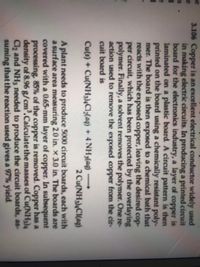
Chemistry
10th Edition
ISBN: 9781305957404
Author: Steven S. Zumdahl, Susan A. Zumdahl, Donald J. DeCoste
Publisher: Cengage Learning
expand_more
expand_more
format_list_bulleted
Question

Transcribed Image Text:3.106 Copper is an excellent electrical conductor widely used
in making electric circuits. In producing a printed circuit
board for the electronics industry, a layer of copper is
laminated on a plastic board. A circuit pattern is then
printed on the board using a chemically resistant poly-
mer. The board is then exposed to a chemical bath that
reacts with the exposed copper, leaving the desired cop-
per circuit, which has been protected by the overlaying
polymer. Finally, a solvent removes the polymer. One re-
action used to remove the exposed copper from the cir-
cuit board is
Cu(s) + Cu(NHy),Cl2(aq) + 4 NH3(aq)
-
2 Cu(NH)C(ag)
A plant needs to produce 5000 circuit boards, each with
a surface area measuring 2.0 in. x 3.0 in. The boards are
covered with a 0.65-mm layer of copper. In subsequent
processing. 85% of the copper is removed. Copper has a
density of 8.96 g/cm'.Calculatethe masses of Cu(NH3)4
Cl2 and NH3 needed to produce the circuit boards, as-
suming that the reaction used gives a 97% yield.
Expert Solution
This question has been solved!
Explore an expertly crafted, step-by-step solution for a thorough understanding of key concepts.
This is a popular solution
Trending nowThis is a popular solution!
Step by stepSolved in 2 steps with 2 images

Knowledge Booster
Learn more about
Need a deep-dive on the concept behind this application? Look no further. Learn more about this topic, chemistry and related others by exploring similar questions and additional content below.Similar questions
- How long would it take to plate 6.49 g of nickel onto copper using a 2.0 V power supply with a 437 mA current flow and 0.50 M nickel (II) acetate solution? time in (hr)arrow_forward·25% b.5.0% C.I0% d 50% this reaction Consider 3Mg+2H3PO > Mg(PO)2+3 Hz * how many gram S Of magnesiumonosenate snould be producediF 5.4o grams Of magm re00+with excess nosphori OOCI0 a75 gra m b9.5grams C58.49rams d 1.80 grams esiunarrow_forwardA coil with 193 turns has a magnetic flux of 37.3 nT-m² through each turn when the current is 1.90 mA. (a) What is the inductance of the coil? What are the (b) inductance and (c) flux through each turn when the current is increased to 3.53 mA? (d) What is the maximum emf & across the coil when the current through it is given by i = (2.72 mA)cos(wt), where w = 205 rad/s? (a) Number 3.788894737 Units mH (b) Number 3.788894737 Units mH (c) Number i 6.929947369 Units nWb (d) Number i 2.112687705 Units Varrow_forward
Recommended textbooks for you
 ChemistryChemistryISBN:9781305957404Author:Steven S. Zumdahl, Susan A. Zumdahl, Donald J. DeCostePublisher:Cengage Learning
ChemistryChemistryISBN:9781305957404Author:Steven S. Zumdahl, Susan A. Zumdahl, Donald J. DeCostePublisher:Cengage Learning ChemistryChemistryISBN:9781259911156Author:Raymond Chang Dr., Jason Overby ProfessorPublisher:McGraw-Hill Education
ChemistryChemistryISBN:9781259911156Author:Raymond Chang Dr., Jason Overby ProfessorPublisher:McGraw-Hill Education Principles of Instrumental AnalysisChemistryISBN:9781305577213Author:Douglas A. Skoog, F. James Holler, Stanley R. CrouchPublisher:Cengage Learning
Principles of Instrumental AnalysisChemistryISBN:9781305577213Author:Douglas A. Skoog, F. James Holler, Stanley R. CrouchPublisher:Cengage Learning Organic ChemistryChemistryISBN:9780078021558Author:Janice Gorzynski Smith Dr.Publisher:McGraw-Hill Education
Organic ChemistryChemistryISBN:9780078021558Author:Janice Gorzynski Smith Dr.Publisher:McGraw-Hill Education Chemistry: Principles and ReactionsChemistryISBN:9781305079373Author:William L. Masterton, Cecile N. HurleyPublisher:Cengage Learning
Chemistry: Principles and ReactionsChemistryISBN:9781305079373Author:William L. Masterton, Cecile N. HurleyPublisher:Cengage Learning Elementary Principles of Chemical Processes, Bind...ChemistryISBN:9781118431221Author:Richard M. Felder, Ronald W. Rousseau, Lisa G. BullardPublisher:WILEY
Elementary Principles of Chemical Processes, Bind...ChemistryISBN:9781118431221Author:Richard M. Felder, Ronald W. Rousseau, Lisa G. BullardPublisher:WILEY

Chemistry
Chemistry
ISBN:9781305957404
Author:Steven S. Zumdahl, Susan A. Zumdahl, Donald J. DeCoste
Publisher:Cengage Learning

Chemistry
Chemistry
ISBN:9781259911156
Author:Raymond Chang Dr., Jason Overby Professor
Publisher:McGraw-Hill Education

Principles of Instrumental Analysis
Chemistry
ISBN:9781305577213
Author:Douglas A. Skoog, F. James Holler, Stanley R. Crouch
Publisher:Cengage Learning

Organic Chemistry
Chemistry
ISBN:9780078021558
Author:Janice Gorzynski Smith Dr.
Publisher:McGraw-Hill Education

Chemistry: Principles and Reactions
Chemistry
ISBN:9781305079373
Author:William L. Masterton, Cecile N. Hurley
Publisher:Cengage Learning

Elementary Principles of Chemical Processes, Bind...
Chemistry
ISBN:9781118431221
Author:Richard M. Felder, Ronald W. Rousseau, Lisa G. Bullard
Publisher:WILEY